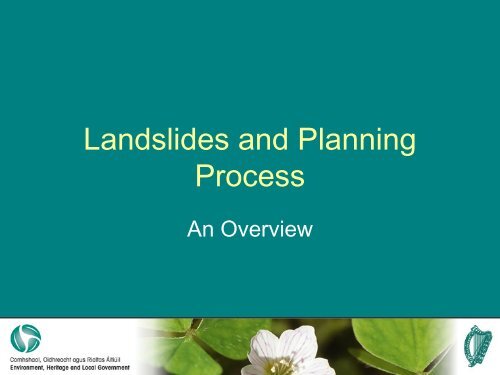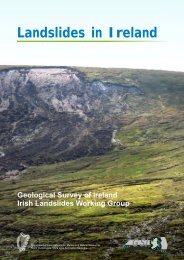Landslides and Planning Process - Geological Survey of Ireland
Landslides and Planning Process - Geological Survey of Ireland
Landslides and Planning Process - Geological Survey of Ireland
You also want an ePaper? Increase the reach of your titles
YUMPU automatically turns print PDFs into web optimized ePapers that Google loves.
<strong>L<strong>and</strong>slides</strong> <strong>and</strong> <strong>Planning</strong><br />
<strong>Process</strong><br />
An Overview
<strong>L<strong>and</strong>slides</strong> Working Group-<br />
recommendations<br />
• <strong>L<strong>and</strong>slides</strong> Working Group<br />
• Increase in awareness <strong>of</strong> l<strong>and</strong>slide hazard<br />
in Irel<strong>and</strong><br />
• Pressure for development in upl<strong>and</strong> areas<br />
• Climate Change<br />
• L<strong>and</strong>scape susceptibility mapping<br />
• L<strong>and</strong>slide hazard <strong>and</strong> the planning<br />
process.
The <strong>Planning</strong> System<br />
• 88 planning authorities<br />
• Main features <strong>of</strong> relevance<br />
– making development plans<br />
– the need for planning permission<br />
– Exempted development<br />
– <strong>Planning</strong> enforcement<br />
– appeals against planning decisions<br />
• Dept role – provide legislative framework <strong>and</strong> policy<br />
guidance-
<strong>Planning</strong> Framework<br />
• <strong>Planning</strong> Acts 2000- 2006<br />
• Hierarchy <strong>of</strong> Strategic / Spatial Plans<br />
– National Spatial Strategy (NSS) - 2002- 2020<br />
– Regional <strong>Planning</strong> Guidelines (RPGs) – 2004-2010<br />
– Development Plans - made every 6 years<br />
– Local Area Plans<br />
• m<strong>and</strong>atory for pop 2000+<br />
• Discretionary e.g. specific areas in need <strong>of</strong><br />
regeneration or under development pressure<br />
– <strong>Planning</strong> Applications
Enviromental Assessment<br />
• Applies to plans <strong>and</strong> projects<br />
• Plan level- Strategic Environmental Assessments ( SEA Directive<br />
2001/42/ EC)<br />
– RPGs- Development Plans- Local Area Plan -from 2004<br />
• Project level Environmental Impact Assessment ( EIA Directive<br />
85/337/EEC as amended by 97/11/EC <strong>and</strong> 2003/35/EC)<br />
– <strong>Planning</strong> Applications<br />
• Key to better integration <strong>of</strong> geo hazards into the planning process
Regional <strong>Planning</strong> Guidelines<br />
(RPGs)<br />
• The overall objective <strong>of</strong> the RPGs is to provide a long-term strategic<br />
planning framework for the development <strong>of</strong> the region which is<br />
consistent with the National Spatial Strategy (NSS)<br />
• They guide <strong>and</strong> inform development plans <strong>and</strong> local area plans <strong>of</strong><br />
the local authorities within the region<br />
• A review <strong>of</strong> the RPGs is required every 6 years <strong>and</strong> must be<br />
completed not later than 6 years from the adoption <strong>of</strong> the first round<br />
<strong>of</strong> RPGs in 2004.<br />
• L<strong>and</strong> instability <strong>and</strong> coastal erosion have been identified in<br />
existing regional plans e.g. SERPGs<br />
• Review <strong>of</strong> RPGs is subject to SEA for the first time<br />
• Potential for future RPGs to highlight issue <strong>of</strong> l<strong>and</strong> instability
Development Plan /LAP<br />
• As provided for in the 2000 Act a Development plans may include –<br />
objectives for “ regulating, restricting or controlling development in<br />
areas at risk <strong>of</strong> flooding ( whether inl<strong>and</strong> or coastal) erosion <strong>and</strong><br />
other natural hazards<br />
– Traditionally objectives are rarely included to deal with l<strong>and</strong>slide<br />
hazard apart from coastal areas.<br />
– Possibly due to relatively low occurrence <strong>of</strong> l<strong>and</strong>slides to date<br />
in populated areas or areas under development pressure.<br />
– Also due to absence <strong>of</strong> information to facilitate mapping <strong>of</strong><br />
areas vulnerable to l<strong>and</strong>slide hazard<br />
– However increasing development pressure in upl<strong>and</strong> area from -<br />
e.g. wind energy - one <strong>of</strong>f housing – recreation activities <strong>and</strong><br />
introduction <strong>of</strong> SEA for Plans - is changing the focus.
Development Plan/ LAP<br />
• Since 2004 all DP / LAP subject to SEA<br />
• It involves a systematic evaluation <strong>of</strong> likely significant environmental<br />
effects <strong>of</strong> objectives in a plan ( can include potential for l<strong>and</strong>slides )<br />
• Making a development plan is a democratic proces <strong>and</strong> involves<br />
significant public consultation<br />
• Its adoption is a reserved function <strong>of</strong> elected members<br />
• Objectives on l<strong>and</strong>slide risk will need to be justified on basis <strong>of</strong><br />
– Robust <strong>and</strong> clear information to identify <strong>and</strong> map areas at risk<br />
– Sound guidance for avoidance <strong>and</strong> /or mitigation measures for<br />
development in areas at risk<br />
• Project on l<strong>and</strong>slide susceptibility mapping <strong>and</strong> risk assessment is<br />
critical to better integration <strong>of</strong> l<strong>and</strong>slides into the planning process .
Development Management<br />
• Potential for l<strong>and</strong>slides is also a consideration at individual<br />
application stage – particularly where EIA applies<br />
• Issue <strong>of</strong> ground stability is increasingly becoming a key<br />
consideration for applications for development projects in upl<strong>and</strong><br />
areas e.g. wind energy - infrastructure projects<br />
• DEHLG Wind Energy Guidelines 2006 highlight importance <strong>of</strong><br />
ground conditions <strong>and</strong> geology for wind energy applications<br />
• Appendix 4 outlines Best Practise for wind energy developments in<br />
peatl<strong>and</strong> areas<br />
• Highlights importance <strong>of</strong> thorough ground investigation including<br />
geotechnical investigation when locating turbine bases<br />
• Susceptibility mapping project will be a key input to assessment <strong>of</strong><br />
development in upl<strong>and</strong> areas
Conclusions<br />
• <strong>L<strong>and</strong>slides</strong> hazard has been integrated into planning process<br />
particularly through the environmental assessment process at<br />
project level<br />
• For the future<br />
– Issue <strong>of</strong> L<strong>and</strong>slide hazard needs to be addressed at all stages<br />
in planning process most critically at DP stage to ensure that<br />
new development does not give rise to l<strong>and</strong>slide risk<br />
– Needs to be supported by robust information on the location <strong>of</strong><br />
areas vulnerable to l<strong>and</strong>slide hazard <strong>and</strong> on appropriate<br />
mitigation measures to avoid the creation <strong>of</strong> risk<br />
– national guidance on l<strong>and</strong>slides will await the outcome <strong>of</strong><br />
current work on l<strong>and</strong>slide susceptibility mapping –<br />
– Draft Flood Risk Guidelines -

















